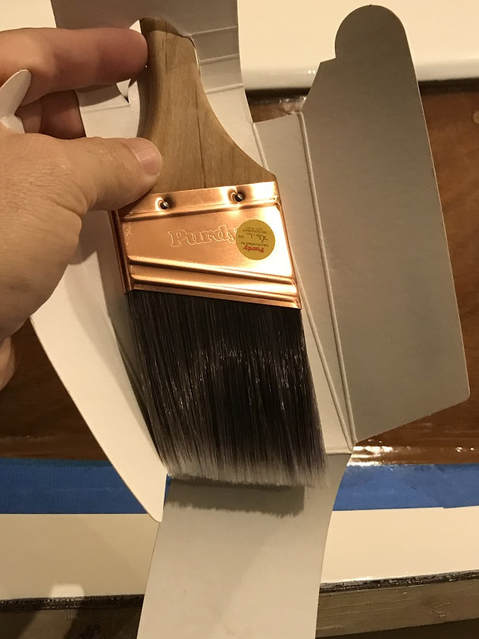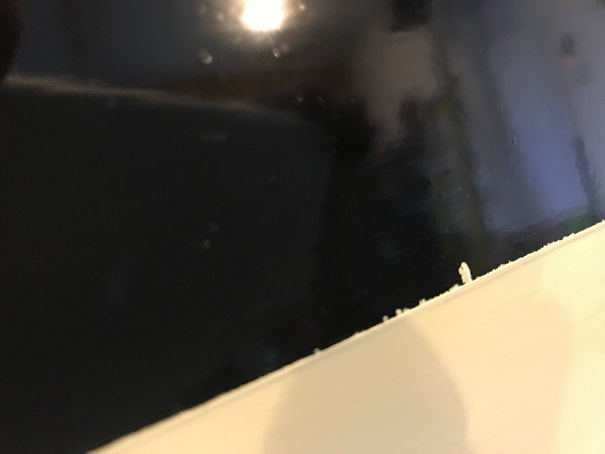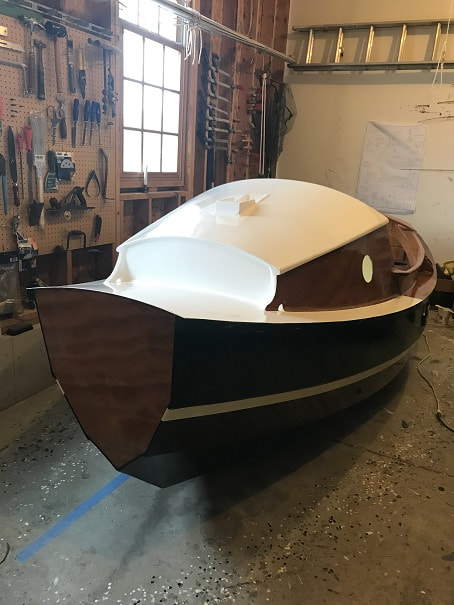The SCAMP Argo has a color scheme that consists of green, black, yellow, cream, white and Varnish. The painting took place in the stages below.
Materials:
- Epifanes Gloss Marine Varnish
- Pettit EZPrime Primer
- Pettit EZPoxy
- Pettit EZPoxy Performance Enhancer Additive 3021
- Pettit 120 Brush Thinner
- Pettit 9900 Skidless Compound
- Purdy XL Semi-Firm 2.5” angled brushes
- Box of clean cotton rags
Painting and Varnishing of SCAMP Argo:
Please note, this page does not include epoxy-coating or presanding of wood or fiberglass; this page covers painting and varnishing.
First, some information on equipment I used.
General Painting and Varnishing Process
To avoid too much repetition below, I will share here the repeated sequence I used during the painting and varnishing process:
- Fairing and smoothing is not covered here, so starting with your faired and smooth surface, begin applying your finishes
- Vacuum the ground around the workspace, kicked up dust will stick to your boat finish when wet.
- After sanding, vacuum the surface
- Then I washed the sanded surface down with a solvent wash of Pettit 120 Brush Thinner on a a clean cotton rag.
- Let the thinner evaporate and apply the varnish or paint in a thin coat. Thick coats of paint, and especially varnish, will drip if they are applied to a vertical surface. I tip the finish smoothly using the brush to achieve a nice final brush stroke.
- After drying thoroughly, I sanded varnish with 120 grit, and paint with 220 grit, then repeat the vacuum, solvent wash, refinish steps above.
Painting and Varnishing the Cockpit Area
The first part of the boat I painted was the cockpit area, sole, and forward interior compartments. I did this work before the deck went on. Note: I did not paint the under-seat compartments, those are epoxied but not painted on the Argo.
- After 3 coats of paint, over the primer, I applied two coats of the anti-skid-laden EZPoxy, worked great.
Painting SCAMP Deck, Roof, and Cabin Sides
- Then I attached the deck and cabin sides and roof, details of which can all be found here
- After attaching the deck, cabin sides, and roof, I painted and varnished them.
- After flipping the boat over, I got to finishing the exterior of the hill.
- Sanding and Fairing of the hull is covered on the Hull Page. The bottom and garboard are fiberglassed and the entire hull exterior has 3 coats of epoxy, followed by the finishes below.
- First, I applied six coats of Epifanes Gloss Marine Varnish to the bow and transom. Between varnish coats: Sanded with 120grit, vacuumed, Pettit 120 Brush Thinner wash with a clean tack cloth. Apply the coats very thin, especially as these are vertical surfaces. Any thick-spots will turn into drips. Prior to each coat, filter the varnish that you will use through a conical paper filter such as pictured below.
- Then I masking taped the bow and transom along the inboard edge of the planks, the end-grain of the planks on the bow and transom will be painted, not varnished.
- With the hull smooth and fair, I applied 3 coats of Pettit EZ Prime, sanding with 120grit between coats. Prior to application, I vacuumed the hull and did a solvent wash with Pettit 120 Brush Thinner
- With this prep work done, I was ready to apply paint. I have chosen to use Pettit EZPoxy to which I am adding Pettit 3021 Performance Enhancer (increases gloss and hardness, improves UV resistance, reduces dry time). I measured our the enhancer, stirred it in with the paint in a small paint pail, and applied with the Purdy XL semi-firm brush.
- It went on great, and I was very positively surprised with the color coverage of the first coat which I applied in a thin film thickness.

FIRST coat of paint. A big moment. I was curious to see if I would have to deal with additional coats, due to my choice to apply a dark paint over white primer, but I was very pleasantly surprised with the amazing coverage of this paint over white primer on the first coat. The varnished bow can be seen here also.
- Completed 3 coats of EZPoxy on stripe
To see detail on how the boat letters and name were applied visit the Applying Boat Name page




























